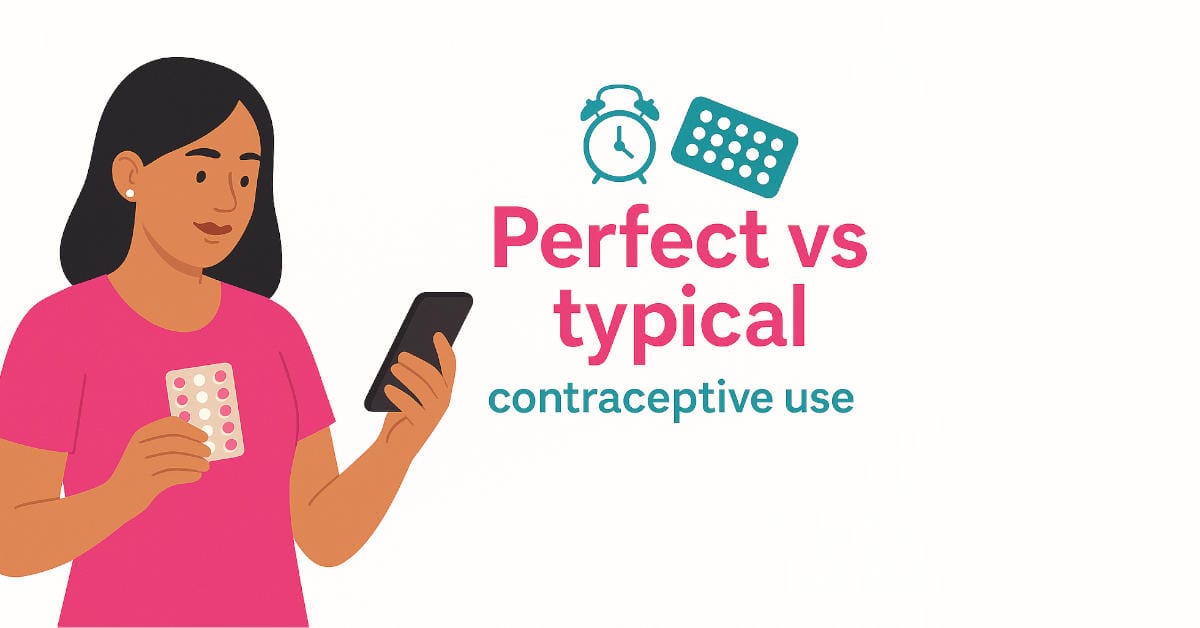When you are choosing birth control, it is easy to focus on the method itself, but how you use it also matters. The gap between perfect use (no mistakes) and typical use (real life) can change your pregnancy risk in a meaningful way.
What “perfect” vs “typical” use means
Perfect use
- Taking the pill at the same time every day with no missed doses.
- Using a condom from start to finish with correct fit and lubricant every time.
- Replacing the ring or patch on schedule, according to instructions.
In clinical studies, some pills prevent about 99% of pregnancies and condoms about 98% when they are used exactly as directed.1
Typical use
- Late or missed pills, or starting a new pack late.
- Condom slips or breaks, or condoms put on late or removed early.
- Missed patch or ring changes, or late injections.
In United States survey based estimates, about 9 in 100 pill users and 15 in 100 condom users become pregnant in a year with typical use. That corresponds to effectiveness of about 91% for pills and 85% for condoms.12
Common slip ups and possible fixes
- Pill: Set one or two phone alarms, keep a spare pack in your bag, and talk with your clinician if timing is often hard. They may suggest strategies or a longer acting method.1
- Condoms: Check the expiry date, pinch the tip, roll to the base, and use water based or silicone based lubricant with latex. Your clinic or pharmacist can show you correct use if you are unsure.4
- Ring or patch: Use calendar reminders or phone apps and change on the recommended schedule rather than “when you remember”.3
- Injection: Before you leave the clinic, book your next appointment and add a reminder so doses stay on time.3
Estimate your real world risk
You can explore an educational estimate that takes into account typical vs perfect use, combining methods, age, and some lifestyle factors:
Open the Advanced Risk Calculator
These calculators are for information only and do not replace medical advice. A clinician can help you interpret results for your own situation.
- Combined Contraceptive Effectiveness Calculator
- Top method combinations
- Methods you should not usually mix
FAQ
Does “typical use” mean I am doing it wrong?
Not necessarily. Typical use describes what happens for many people in day to day life, including late pills, delayed refills, or rushed condom use. Reducing those slip ups where you can, or choosing a method that fits your routine better, can help. A clinician can work with you to find an option that is realistic for you.
Which methods are least sensitive to “use quality”?
Long acting methods such as hormonal or copper IUDs, the implant, and permanent procedures like sterilisation have a small gap between perfect and typical use because there is little to remember after placement. Sterilisation is permanent and is only suitable for people who are sure they do not want a future pregnancy.3
How much does a late pill matter?
It depends on the pill type and how late it was. Late or missed doses are a major reason for the drop from perfect to typical use. Follow the instructions that come with your specific pill and contact your clinician or pharmacist if you are unsure whether you need a backup method.1
Do condoms still help if I am on the pill?
Yes. Condoms add a second pregnancy barrier and they help reduce the risk of many sexually transmitted infections. Many clinicians recommend using condoms as well as a hormonal method, especially if there is any chance of late or missed pills or if you are not in a mutually monogamous relationship.4
Sources
- Trussell J. Contraceptive failure in the United States. Contraception. 2011;83(5):397-404. PubMed
- Kost K, et al. Estimates of contraceptive failure from the 2002 NSFG. Contraception. 2008;77(1):10-21. PubMed
- CDC. U.S. Selected Practice Recommendations for Contraceptive Use, 2024. MMWR
- CDC. Condoms and HIV Prevention. Correct and consistent use guidance. cdc.gov
This page is educational and is not medical advice. For personal recommendations, talk with a doctor, nurse, or other qualified clinician.

